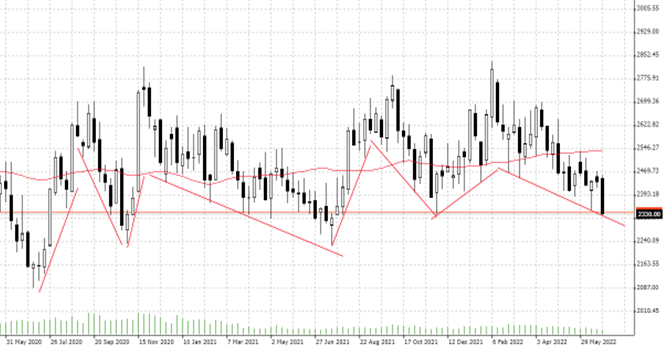

01.07.2022 – For quite some time, the trend in cocoa has been running aimlessly sideways. In the short term, however, smaller waves have repeatedly formed, inviting traders to surf from intermediate highs to troughs and back again. Hardly any other product is so torn between the factors of impending recession, problems at producers, inflation and global population explosion.
You can see the contradictory situation very nicely in the weekly chart. The price oscillates indecisively around the 50 line. And again and again there are well tradable, short-term trend lines.

Source: Bernstein Bank GmbH
The picture is the way it is for good reason. Because when it comes to fundamentals, we see a tug-of-war between bulls and bears.
Bullish: Poor Harvest
Exporters suggest, according to industry service Trading Economics, that farmers in Côte d’Ivoire shipped about 1.97 million tons of cocoa beans to ports from the previous October 01 to the end of June this year. This is down 4.9 percent from the previous year. In neighboring Ghana, production fell dramatically to 800,000 tons from the previous record harvest of 1.047 million tons.
Both countries are the absolute top producers, accounting for over 60 percent of global supply. Harvests here fluctuate because of misuse of pesticides, infestation with fungi, groundwater levels and government destruction of illegal farms in the rainforest. Other major producers include Indonesia, Nigeria, Cameroon, Ecuador and Brazil. At around 5 million tons, cocoa is the world’s smallest soft commodity.
Bearish: oversupply
Despite falling supply, prices are under pressure, according to “Trading Economics.” This is because the warehouses of traders registered with the Intercontinental Exchange (ICE) in London are significantly better filled than in the previous season. Fittingly, global lobby group The International Cocoa Organization (ICCO) reported the 2020/21 season has resulted in a global oversupply of 230,000 metric tons – the largest since the 2016/17 season.
Bearish: tight budget
In addition, as inflation soars, the ICCO warned of falling global demand in non-essential goods and luxury items. And this includes cocoa and all its sub-forms, especially chocolate.
Bullish: Corona opening and population explosion
However, ING Economic and Financial Analysis pointed out that the reopening of economies in the post-Corona world is constructive for demand. Investing.com already positioned itself bullish a few weeks ago: the movement in other soft commodities such as coffee, sugar or orange juice also points to an upward breakout in cocoa. There are good reasons for this assumption: First, the world population is growing by around 20 million people every quarter, which supports demand.
Bullish: Inflation
In addition, according to Investing.com, the highest inflation in four decades is raising production costs for wages, fertilizer and transportation. This, it says, is putting upward pressure on prices as farmers add costs to the product. We add: In fact, the all-time high in 1977 was nearly $4,600 in the wake of the first oil shock.
As you can see, there are plenty of arguments for both long and short trades. We hope that you position yourself correctly in this mixed situation – Bernstein Bank wishes you successful trades and investments!
Important Notes on This Publication:
The content of this publication is for general information purposes only. In this context, it is neither an individual investment recommendation or advice nor an offer to purchase or sell securities or other financial products. The content in question and all the information contained therein do not in any way replace individual investor- or investment-oriented advice. No reliable forecast or indication for the future is possible with respect to any presentation or information on the present or past performance of the relevant underlying assets. All information and data presented in this publication are based on reliable sources. However, Bernstein Bank does not guarantee that the information and data contained in this publication is up-to-date, correct and complete. Securities traded on the financial markets are subject to price fluctuations. A contract for difference (CFD) is also a financial instrument with leverage effect. Against this backdrop, CFD trading involves a high risk up to the point of total loss and may not be suitable for all investors. Therefore, make sure that you have fully understood all the correlating risks. If necessary, ask for independent advice. CFDs are complex instruments and are associated with the high risk of losing money quickly because of the leverage effect. 68% of retail investor accounts lose money trading CFD with this provider. You should consider whether you understand how CFD work and whether you can afford to take the high risk of losing your money.7
